ABCG2 transports and transfers heme to albumin through its large extracellular loop
- PMID: 20705604
- PMCID: PMC2963377
- DOI: 10.1074/jbc.M110.139170
ABCG2 transports and transfers heme to albumin through its large extracellular loop
Abstract
ABCG2 is an ATP-binding cassette (ABC) transporter preferentially expressed by immature human hematopoietic progenitors. Due to its role in drug resistance, its expression has been correlated with a protection role against protoporhyrin IX (PPIX) accumulation in stem cells under hypoxic conditions. We show here that zinc mesoporphyrin, a validated fluorescent heme analog, is transported by ABCG2. We also show that the ABCG2 large extracellular loop ECL3 constitutes a porphyrin-binding domain, which strongly interacts with heme, hemin, PPIX, ZnPPIX, CoPPIX, and much less efficiently with pheophorbide a, but not with vitamin B12. K(d) values are in the range 0.5-3.5 μm, with heme displaying the highest affinity. Nonporphyrin substrates of ABCG2, such as mitoxantrone, doxo/daunorubicin, and riboflavin, do not bind to ECL3. Single-point mutations H583A and C603A inside ECL3 prevent the binding of hemin but hardly affect that of iron-free PPIX. The extracellular location of ECL3 downstream from the transport sites suggests that, after membrane translocation, hemin is transferred to ECL3, which is strategically positioned to release the bound porphyrin to extracellular partners. We show here that human serum albumin could be one of these possible partners as it removes hemin bound to ECL3 and interacts with ABCG2, with a K(d) of about 3 μm.
Figures
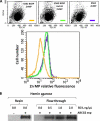
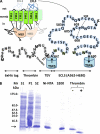
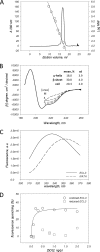

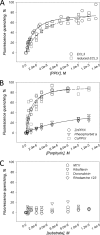
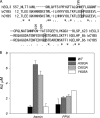

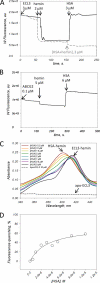
Similar articles
-
Serum-dependent export of protoporphyrin IX by ATP-binding cassette transporter G2 in T24 cells.Mol Cell Biochem. 2011 Dec;358(1-2):297-307. doi: 10.1007/s11010-011-0980-5. Epub 2011 Jul 12. Mol Cell Biochem. 2011. PMID: 21748335
-
One ring is not enough to rule them all. Albumin-dependent ABCG2-mediated transport of chlorophyll-derived photosensitizers.Eur J Pharm Sci. 2021 Dec 1;167:106001. doi: 10.1016/j.ejps.2021.106001. Epub 2021 Sep 11. Eur J Pharm Sci. 2021. PMID: 34517107
-
ABCG2 influence on the efficiency of photodynamic therapy in glioblastoma cells.J Photochem Photobiol B. 2020 Sep;210:111963. doi: 10.1016/j.jphotobiol.2020.111963. Epub 2020 Jul 18. J Photochem Photobiol B. 2020. PMID: 32795847
-
Multidrug resistance in cancer chemotherapy and xenobiotic protection mediated by the half ATP-binding cassette transporter ABCG2.Curr Med Chem Anticancer Agents. 2004 Jan;4(1):31-42. doi: 10.2174/1568011043482205. Curr Med Chem Anticancer Agents. 2004. PMID: 14754410 Review.
-
The role of ABCG2 and ABCB6 in porphyrin metabolism and cell survival.Curr Pharm Biotechnol. 2011 Apr;12(4):647-55. doi: 10.2174/138920111795163995. Curr Pharm Biotechnol. 2011. PMID: 21118089 Review.
Cited by
-
One ring to bring them all and in the darkness bind them: The trafficking of heme without deliverers.Biochim Biophys Acta Mol Cell Res. 2021 Jan;1868(1):118881. doi: 10.1016/j.bbamcr.2020.118881. Epub 2020 Oct 3. Biochim Biophys Acta Mol Cell Res. 2021. PMID: 33022276 Free PMC article. Review.
-
Aminolevulinic Acid-Based Tumor Detection and Therapy: Molecular Mechanisms and Strategies for Enhancement.Int J Mol Sci. 2015 Oct 28;16(10):25865-80. doi: 10.3390/ijms161025865. Int J Mol Sci. 2015. PMID: 26516850 Free PMC article. Review.
-
ABCG2 polymorphisms in gout: insights into disease susceptibility and treatment approaches.Pharmgenomics Pers Med. 2017 Apr 20;10:129-142. doi: 10.2147/PGPM.S105854. eCollection 2017. Pharmgenomics Pers Med. 2017. PMID: 28461764 Free PMC article. Review.
-
A new porphyrin as selective substrate-based inhibitor of breast cancer resistance protein (BCRP/ABCG2).Chem Biol Interact. 2022 Jan 5;351:109718. doi: 10.1016/j.cbi.2021.109718. Epub 2021 Oct 27. Chem Biol Interact. 2022. PMID: 34717915 Free PMC article.
-
Induction of immune mediators in glioma and prostate cancer cells by non-lethal photodynamic therapy.PLoS One. 2011;6(6):e21834. doi: 10.1371/journal.pone.0021834. Epub 2011 Jun 30. PLoS One. 2011. PMID: 21738796 Free PMC article.
References
-
- Dean M., Hamon Y., Chimini G. (2001) J. Lipid Res. 42, 1007–1017 - PubMed
-
- Ross D. D., Yang W., Abruzzo L. V., Dalton W. S., Schneider E., Lage H., Dietel M., Greenberger L., Cole S. P., Doyle L. A. (1999) J. Natl. Cancer Inst. 91, 429–433 - PubMed
-
- Litman T., Brangi M., Hudson E., Fetsch P., Abati A., Ross D. D., Miyake K., Resau J. H., Bates S. E. (2000) J. Cell Sci. 113, 2011–2021 - PubMed
-
- Sarkadi B., Ozvegy-Laczka C., Német K., Váradi A. (2004) FEBS Lett. 567, 116–120 - PubMed
-
- Wang X., Baba M. (2005) Antivir. Chem. Chemother. 16, 213–216 - PubMed
Publication types
MeSH terms
Substances
LinkOut - more resources
Full Text Sources
Molecular Biology Databases

